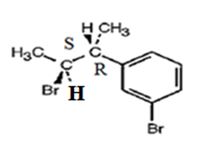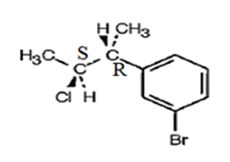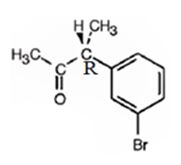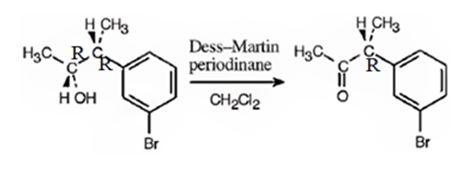
a) PBr3
Interpretation:
The product obtained when 3-(m-bromophenyl)-2-butanol is treated with PBr3.
Concept introduction:
Alcohols when reacted with PBr3 yield the corresponding alkyl bromides along with H3BO3. When treated with aqueous H2SO4 they undergo dehydration to give
To give:
The products obtained when the alcohol shown is treated with PBr3.
Answer to Problem 22VC
The product obtained when the alcohol is treated with PBr3 is

Explanation of Solution
The reaction of the alcohol with PBr3 is a bimolecular nucleophilic substitution (SN2) reaction. It takes place with inversion in configuration at the reaction centre to yield an alkyl bromide.

The product obtained when the alcohol is treated with PBr3 is

b) H2SO4
Interpretation:
The product obtained when 3-(m-bromophenyl)-2-butanol is treated with aqueous H2SO4.
Concept introduction:
Alcohols when reacted with PBr3 yield the corresponding alkyl bromides along with H3BO3. When treated with aqueous H2SO4 they undergo dehydration to give alkenes. They react with SOCl2 to yield the corresponding alkyl halide along with SO2 and HCl. Dess-Martin periodinate oxidizes 20 alcohols to ketones. In aromatic electrophilic substitution reactions the alkyl group is an ortho and para directing and activating group. Bromine also is an ortho and para directing but deactivating group.
To give:
The products obtained when the alcohol shown is treated with aqueous H2SO4.
Answer to Problem 22VC
The products obtained when the alcohol is treated with aqueous H2SO4 are two isomeric alkenes (E) and (Z). E isomer is obtained as the major product.

Explanation of Solution
The alcohol gets dehydrated when treated with aqueous H2SO4 yields the E and Z isomers of an alkene. The E isomer is more stable and obtained as the major product as the bulky groups are far away.

The products obtained when the alcohol is treated with aqueous H2SO4 isomeric alkenes (E) and (Z) are produced. E isomer is obtained as the major product.

c) SOCl2
Interpretation:
The product obtained when 3-(m-bromophenyl)-2-butanol is treated with SOCl2.
Concept introduction:
Alcohols when reacted with PBr3 yield the corresponding alkyl bromides along with H3BO3. When treated with aqueous H2SO4 they undergo dehydration to give alkenes. They react with SOCl2 to yield the corresponding alkyl halide along with SO2 and HCl. Dess-Martin periodinate oxidizes 20 alcohols to ketones. In aromatic electrophilic substitution reactions the alkyl group is an ortho and para directing and activating group. Bromine also is an ortho and para directing but deactivating group.
To give:
The products obtained when the alcohol shown is treated with SOCl2.
Answer to Problem 22VC
The product obtained when the alcohol is treated with SOCl2 is

Explanation of Solution
The reaction of the alcohol with SOCl2 is a bimolecular nucleophilic substitution (SN2) reaction. It takes place with inversion in configuration at the reaction centre to yield an alkyl chloride.

The product obtained when the alcohol is treated with SOCl2 is

d) Dess-Martin periodinate
Interpretation:
The product obtained when 3-(m-bromophenyl)-2-butanol is treated with Dess-Martin periodinate.
Concept introduction:
Alcohols when reacted with PBr3 yield the corresponding alkyl bromides along with H3BO3. When treated with aqueous H2SO4 they undergo dehydration to give alkenes. They react with SOCl2 to yield the corresponding alkyl halide along with SO2 and HCl. Dess-Martin periodinate oxidizes 20 alcohols to ketones. In aromatic electrophilic substitution reactions the alkyl group is an ortho and para directing and activating group. Bromine also is an ortho and para directing but deactivating group.
To give:
The products obtained when the alcohol shown is treated with Dess-Martin periodinate.
Answer to Problem 22VC
The product obtained when the alcohol is treated with Dess-Martin periodinate is

Explanation of Solution
The alcohol is a 20 in nature. Dess-Martin periodinate oxidizes it into a ketone.

The product obtained when the alcohol is treated with Dess-Martin periodinate is

e) Br2, FeBr3
Interpretation:
The product obtained when 3-(m-bromophenyl)-2-butanol is treated Br2, FeBr3.
Concept introduction:
Alcohols when reacted with PBr3 yield the corresponding alkyl bromides along with H3BO3. When treated with aqueous H2SO4 they undergo dehydration to give alkenes. They react with SOCl2 to yield the corresponding alkyl halide along with SO2 and HCl. Dess-Martin periodinate oxidizes 20 alcohols to ketones. In aromatic electrophilic substitution reactions the alkyl group is an ortho and para directing and activating group. Bromine also is an ortho and para directing but deactivating group.
To give:
The products obtained when the alcohol shown is treated Br2, FeBr3.
Answer to Problem 22VC
The products obtained when the alcohol is treated with Br2, FeBr3 are

Explanation of Solution
The alcohol undergoes bromination in the benzene ring when treated with Br2, FeBr3. Both bromine and an alkyl group are attached to the ring. Both alkyl and Br are ortho and para directing, the alkyl is activating while the Br is deactivating. Hence during bromination the bromine enters into the ortho and para positions to yield the products.

The products obtained when the alcohol is treated with Br2, FeBr3 are

Want to see more full solutions like this?
Chapter 17 Solutions
Organic Chemistry
- Draw the titration curve of (i) weak acid vs. strong base; (ii) weak acid vs. weakbase; (iii) diprotic acid with strong base (iii) triprotic acid with strong base.arrow_forwardComplete the reaction in the drawing area below by adding the major products to the right-hand side. If there won't be any products, because nothing will happen under these reaction conditions, check the box under the drawing area instead. Note: if the products contain one or more pairs of enantiomers, don't worry about drawing each enantiomer with dash and wedge bonds. Just draw one molecule to represent each pair of enantiomers, using line bonds at the chiral center. More... No reaction. my ㄖˋ + 1. Na O Me Click and drag to start drawing a structure. 2. H +arrow_forwardPredict the intermediate 1 and final product 2 of this organic reaction: NaOMe H+ + 1 2 H H work up You can draw 1 and 2 in any arrangement you like. Note: if either 1 or 2 consists of a pair of enantiomers, just draw one structure using line bonds instead of 3D (dash and wedge) bonds at the chiral center. Click and drag to start drawing a structure. X $ dmarrow_forward
- Predict the major products of this organic reaction: 1. NaH (20°C) 2. CH3Br ? Some notes: • Draw only the major product, or products. You can draw them in any arrangement you like. • Be sure to use wedge and dash bonds where necessary, for example to distinguish between major products that are enantiomers. • If there are no products, just check the box under the drawing area. No reaction. Click and drag to start drawing a structure. G Crarrow_forwardPredict the major products of this organic reaction: 1. LDA (-78°C) ? 2. Br Some notes: • Draw only the major product, or products. You can draw them in any arrangement you like. . • Be sure to use wedge and dash bonds where necessary, for example to distinguish between major products that are enantiomers. • If there are no products, just check the box under the drawing area. No reaction. Click and drag to start drawing a structure. Xarrow_forwardPlease draw the structuresarrow_forward
- Draw the missing intermediates 1 and 2, plus the final product 3, of this synthesis: 0 1. Eto 1. Eto- 1 2 2. MeBr 2. EtBr H3O+ A 3 You can draw the three structures in any arrangement you like. Explanation Check Click and drag to start drawing a structure.arrow_forwardDraw the missing intermediate 1 and final product 2 of this synthesis: 1. MeO- H3O+ 1 2 2. PrBr Δ You can draw the two structures in any arrangement you like. Click and drag to start drawing a structure.arrow_forwardWhat is the differences between: Glyceride and phosphoglyceride Wax and Fat Soap and Fatty acid HDL and LDL cholesterol Phospho lipids and sphingosine What are the types of lipids? What are the main lipid components of membrane structures? How could lipids play important rules as signaling molecules and building units? The structure variety of lipids makes them to play significant rules in our body, conclude breifly on this statement.arrow_forward
- What is the differences between DNA and RNA for the following: - structure - function - type What is the meaning of: - replication - transcription - translation show the base pair connection(hydrogen bond) in DNA and RNAarrow_forwardWhat is the IP for a amino acid- give an example what are the types of amino acids What are the structures of proteins The N-Terminal analysis by the Edman method shows saralasin contains sarcosine at the N-terminus. Partial hydrolysis of saralasin with dilute hydrochloric acid yields the following fragments: Try-Val-His Sar-Arg-Val His-Pro-Ala Val- Tyr- Val Arg-Val-Tyr What is the structure of saralasin?arrow_forwardWhat is the IP for a amino acid- give an example what are the types of amino acids What are the structures of proteins The N-Terminal analysis by the Edman method shows saralasin contains sarcosine at the N-terminus. Partial hydrolysis of saralasin with dilute hydrochloric acid yields the following fragments: Try-Val-His Sar-Arg-Val His-Pro-Ala Val- Tyr- Val Arg-Val-Tyr What is the structure of saralasin?arrow_forward
 Organic ChemistryChemistryISBN:9781305580350Author:William H. Brown, Brent L. Iverson, Eric Anslyn, Christopher S. FootePublisher:Cengage Learning
Organic ChemistryChemistryISBN:9781305580350Author:William H. Brown, Brent L. Iverson, Eric Anslyn, Christopher S. FootePublisher:Cengage Learning

